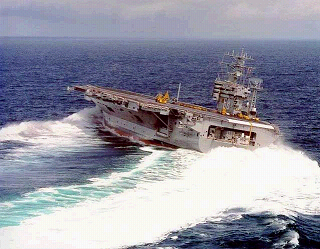
I recently read a book in which the author claims that changing a culture is like turning an aircraft carrier. I frankly think his simile totally misses the mark. For starters, an aircraft carrier is quite nimble for its size and turning it is actually quite simple. The Junior Officer of the Deck (JOOD) gives orders to the helmsman (who controls the rudder) about the direction of the turn and to the lee helmsman (who controls the engines) about the speed of the turn.
Unlike other large ships, an aircraft carrier has 4 engines and can turn very quickly (even within its own length) by reversing two screws while the others are moving forward. This makes turning an aircraft carrier child's play when compared to changing a culture. Here are my top 5 reasons why culture change is more difficult.
5. "Business as Usual" is Not Allowed: On an aircraft carrier, there are whole groups of crew members who conduct business as usual while the JOOD and helmsmen are charting and setting a new course. Not so in a culture change. Successful culture change involves everyone at every level of every department. "Business as usual" is not allowed. No department is untouched. Everyone must live the change...or leave. Everyone, especially managers, needs the insight, creativity and courage to say this process isn't working any more or I can think of a better way to do this - and then to take action to change processes, policies and systems.
4. Checklists Not Available: Because aircraft carrier crews change with new enlistments (and for other reasons) the steps, tools and techniques for turning a carrier are well codified - and they are transferable between carriers of the same class. Not so with culture change. Culture change is unique to each organization - there are no checklists. The steps, tools and techniques that are successful in one organization don't automatically transfer to another.
3. It's Not About Mechanisms, It's About Hearts and Minds: Turning an aircraft carrier involves engaging mechanisms (rudder and engines). Culture change means engaging hearts and minds. It requires personal change...from everyone! Consider this quote, "People will accept management's conclusions, but people will act on their own conclusions." It tells us that when people can answer the questions why is the organization changing? and what does the change require of me?, they become part of the transformation thus accelerate the change. This creates a force for change that no aircraft carrier can claim.
2. Every Manager for Her/Himself...Not! On an aircraft carrier many officers can be successful at their jobs without being involved with the helmsmen and JOOD. Not so in an organization. The force for change that can be harnessed when staff members act on their own conclusions is accelerated by managers who are focused on helping each other succeed. Looking for cross-departmental improvement opportunities, recognizing staff for aligned behavior - even if they don't report to you - and refraining from casting blame on other departments are examples of the fact that we change together or we fail together.
1. And the number 1 reason that changing a culture is not like turning an aircraft carrier...It's Not About Command & Control: When turning an aircraft carrier the JOOD issues a series of commands that are followed to the letter and the carrier (all things being equal) changes course. In a culture change, leaders at all levels have to not only engage and align staff (see #3 above), but also have to be role models for the change.
If turning an aircraft carrier is child's play compared to changing a culture, what's changing a culture like? I would say it's like training a horse, but that's a discussion for a different article.
--
*I thank a friend who is a retired Naval officer for providing details about what happens when the JOOD, who typically has the con, turns an aircraft carrier.






